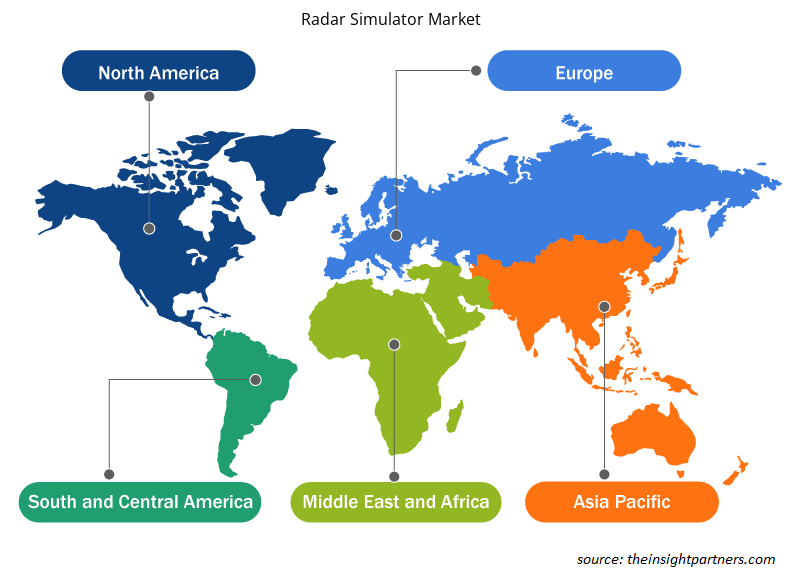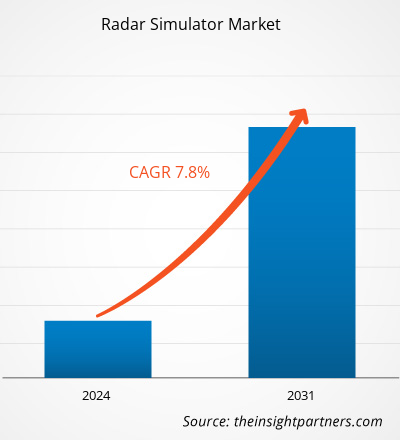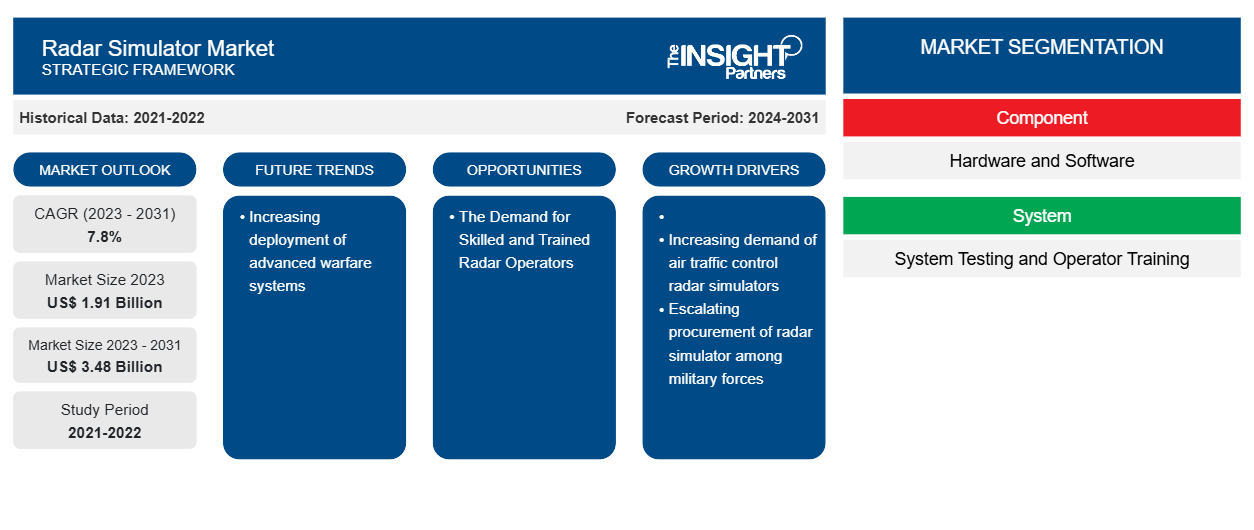Der Markt für Radarsimulatoren soll von 1,91 Milliarden US-Dollar im Jahr 2023 auf 3,48 Milliarden US-Dollar im Jahr 2031 anwachsen. Der Markt dürfte zwischen 2023 und 2031 eine durchschnittliche jährliche Wachstumsrate von 7,8 % verzeichnen. Der zunehmende Einsatz moderner Kriegsführungssysteme dürfte ein wichtiger Trend auf dem Markt bleiben.
Radarsimulator-Marktanalyse
Zu den wichtigsten Akteuren im globalen Ökosystem des Radarsimulatormarkts zählen Rohstoff- und Komponentenanbieter, Hersteller und Entwickler von Radarsimulatoren, Systemintegratoren und Endnutzer. Komponenten- und Hardwareanbieter bieten zahlreiche Teile und Komponenten für Hersteller von Radarsimulatoren an. Zur Herstellung von Radarsimulatoren werden unterschiedliche Arten von Komponenten verwendet, darunter Antennen, Empfänger, Wellenformgeneratoren und Mikrocontroller . Die rechtzeitige Lieferung all dieser Komponenten ist für einen effizienten Betrieb in den Produktionsanlagen für Radarsimulatoren von entscheidender Bedeutung. Daher wirken sich alle betrieblichen Auswirkungen auf diese Komponentenanbieter direkt auf den Radarsimulatormarkt aus.
Radarsimulator-Marktübersicht
Die wichtigsten Akteure in der Wertschöpfungskette sind die Hersteller von Radarsimulatoren und Softwareentwickler. Sie bieten den Endverbrauchssektoren das fertige integrierte Produkt an. Zu den wichtigsten Akteuren auf dem Markt zählen Collins Aerospace, L3Harris Technologies, Inc., Mercury Systems, Inc., Ultra Electronics Holdings plc und ARI Simulation. Die auf dem Markt tätigen Systemintegratoren integrieren die Hardware- und Softwarelösungen, um den Endverbrauchern auf dem globalen Radarsimulatormarkt das Endprodukt anzubieten.
Passen Sie diesen Bericht Ihren Anforderungen an
Sie erhalten kostenlos individuelle Anpassungen an jedem Bericht, einschließlich Teilen dieses Berichts oder einer Analyse auf Länderebene, eines Excel-Datenpakets sowie tolle Angebote und Rabatte für Start-ups und Universitäten.
- Holen Sie sich die wichtigsten Markttrends aus diesem Bericht.Dieses KOSTENLOSE Beispiel umfasst eine Datenanalyse von Markttrends bis hin zu Schätzungen und Prognosen.
Markttreiber und Chancen für Radarsimulatoren
Zunehmende Beschaffung von Radarsimulatoren bei Streitkräften
Die Sicherheitsbedenken in öffentlichen Einrichtungen, an Landesgrenzen und an Land, in Marinehäfen und Luftwaffenstützpunkten nehmen weltweit kontinuierlich zu. Die effektive Verwaltung und Kontrolle von Bedrohungen aus der Luft, zu Wasser oder am Boden mithilfe von Radarsystemen ist für die Militär- und Sicherheitsbehörden aller Regionen der Welt zu einem wichtigen Paradigma geworden. Radarsysteme und Radarsimulatoren werden immer häufiger eingesetzt, um die Sicherheit militärischer Operationen und des Personals sowie eine effiziente Ausbildung der Radarbediener zu gewährleisten. Viele Länder wie die USA, China, Indien, Japan, Australien, Kanada, Deutschland, Frankreich und Großbritannien beschaffen Radarsimulatoren, um ihre jeweiligen Streitkräfte zu stärken und Bediener für den Kampf gegen die Bedrohungen durch häufig auftretende moderne Luftangriffe auszubilden. Radarsimulatoren helfen Militärbeamten außerdem dabei, Gegenpläne für den Fall von Angriffen durch unbekannte Bedrohungen auszuarbeiten. Die Beschaffung von Radarsimulatoren hat in den Militärsektoren verschiedener Länder zugenommen, und die Regierungen dieser Länder schlagen höhere Militärausgaben vor, um den Militär- und Verteidigungssektoren die Beschaffung modernerer Radarsysteme und Radarsimulatoren zu ermöglichen.
Die Nachfrage nach qualifizierten und ausgebildeten Radarbedienern
Der Aufstieg moderner Flugsicherungstürme und fortschrittlicher Militärtechnologien hat zu einer steigenden Nachfrage nach Bedienern geführt, die in der Lage sind, mit moderner Bodenausrüstung für Flugzeuge und Militärtechnologie zu arbeiten. Radarsimulatoren verarbeiten große Mengen unverarbeiteter Radarsignaldaten, um nicht identifizierte Bedrohungen aus der Luft, von der See oder andere Objekte innerhalb der definierten Grenzen aufzudecken. Die Nutzung von Radarsimulatoren bei den Militär- und Verteidigungskräften verschiedener Länder hat zugenommen, was hohe Investitionen in die Entwicklung und Forschung der Radarsimulationstechnologie ausgelöst hat. Dies hat zu einer Nachfrage nach hochqualifizierten und ausgebildeten Radarbedienern auf Flughäfen, Luftwaffenstützpunkten, Marineschiffen, militärischen Frachtschiffen und Marinehäfen geführt. Die Tatsache, dass diese Nachfrage in den kommenden Jahren voraussichtlich steigen wird, bietet den wichtigsten Marktteilnehmern sowie dem gesamten Radarsimulatormarkt in den kommenden Jahren enorme Wachstumschancen. Da die Luft- und Raumfahrt- und Verteidigungssektoren im Prognosezeitraum voraussichtlich wachsen werden, wird dies voraussichtlich die Nachfrage nach qualifizierten, ausgebildeten und erfahrenen Radarbedienern zum Schutz des Luftraums, der Wasserstraßen und der Landgrenzen der Länder weiter steigern. Daher ist zu erwarten, dass die Nachfrage nach qualifizierten und ausgebildeten Radarbedienern in der kommerziellen und militärischen Luftfahrt sowie bei den See- und Bodentruppen den Markt für Radarsimulatoren in absehbarer Zukunft ankurbeln wird.
Radarsimulator-Marktbericht – Segmentierungsanalyse
Wichtige Segmente, die zur Ableitung der Radarsimulator-Marktanalyse beigetragen haben, sind Komponente, System und Anwendung.
- Basierend auf den Komponenten ist der Markt für Radarsimulatoren in Hardware und Software unterteilt. Das Hardwaresegment hatte im Jahr 2023 einen größeren Marktanteil.
- Basierend auf dem System ist der Radarsimulatormarkt in Systemtests und Bedienerschulungen unterteilt. Das Segment Bedienerschulungen hatte im Jahr 2023 einen größeren Marktanteil.
- Basierend auf der Anwendung ist der Markt für Radarsimulatoren in militärische und kommerzielle unterteilt. Das kommerzielle Segment hatte im Jahr 2023 einen größeren Marktanteil.
Radarsimulator-Marktanteilsanalyse nach Geografie
Der geografische Umfang des Marktberichts für Radarsimulatoren ist hauptsächlich in fünf Regionen unterteilt: Nordamerika, Europa, Asien-Pazifik, Naher Osten und Afrika sowie Südamerika.
Nordamerika dominierte den Markt im Jahr 2023, gefolgt von Europa und dem asiatisch-pazifischen Raum. Darüber hinaus wird der asiatisch-pazifische Raum in den kommenden Jahren wahrscheinlich auch die höchste durchschnittliche jährliche Wachstumsrate verzeichnen. Die USA dominierten den nordamerikanischen Radarsimulatormarkt im Jahr 2023. Dies ist hauptsächlich auf die frühe Einführung der Radarsimulatortechnologie zurückzuführen. Darüber hinaus verfügen die USA über das größte Verteidigungsbudget der Welt und ein großer Teil des Budgets wird für die Einführung und Beschaffung modernisierter Waffensysteme bereitgestellt. Dies trägt zur Nachfrage nach Radarsimulatoren im ganzen Land bei. Die steigende Zahl von Flugzeugen bei der US-Luftwaffe und beim Militär ist ebenfalls ein unterstützender Faktor für das Marktwachstum im Land. Die zunehmende Nutzung von Radarsimulatoren zur genauen Simulation realen Geländes sowie von Wettermustern und Zielen in den USA treibt auch das Marktwachstum im Land voran. Die steigende Nachfrage nach neuen und fortschrittlichen Radarsimulatoren in den USA ist ein wichtiger Faktor für das Wachstum des Marktes. Auch Radarsimulatoren, die die Möglichkeit zur Wetterradarsimulation bieten, werden in den USA immer beliebter. Der weitverbreitete Einsatz von Radarsimulatoren für kommerzielle Schulungs- und Ausbildungszwecke von Piloten und Luftunterstützungspersonal hat im Land zugenommen. Darüber hinaus fördert die Einführung von Radarsimulatoren zur Erstellung komplexer Multiradar- und Multizielsimulationen, wodurch Systeme anhand von Radardaten getestet werden können, das Marktwachstum in den USA. Die Präsenz verschiedener wichtiger Marktteilnehmer wie Cambridge Pixel Ltd (USA), Harris Corporation (USA), Buffalo Computer Graphics (USA), Mercury Systems, Inc. (USA), Textron Systems (USA) und Rockwell Collins (USA) unterstützt das Marktwachstum im Land.
Regionale Einblicke in den Radarsimulatormarkt
Die regionalen Trends und Faktoren, die den Radarsimulatormarkt während des gesamten Prognosezeitraums beeinflussen, wurden von den Analysten von Insight Partners ausführlich erläutert. In diesem Abschnitt werden auch Radarsimulatormarktsegmente und -geografie in Nordamerika, Europa, im asiatisch-pazifischen Raum, im Nahen Osten und Afrika sowie in Süd- und Mittelamerika erörtert.

- Erhalten Sie regionale Daten zum Radarsimulatormarkt
Umfang des Marktberichts zum Radarsimulator
| Berichtsattribut | Details |
|---|---|
| Marktgröße im Jahr 2023 | 1,91 Milliarden US-Dollar |
| Marktgröße bis 2031 | 3,48 Milliarden US-Dollar |
| Globale CAGR (2023 - 2031) | 7,8 % |
| Historische Daten | 2021-2022 |
| Prognosezeitraum | 2024–2031 |
| Abgedeckte Segmente | Nach Komponente
|
| Abgedeckte Regionen und Länder | Nordamerika
|
| Marktführer und wichtige Unternehmensprofile |
|
Marktteilnehmerdichte: Der Einfluss auf die Geschäftsdynamik
Der Markt für Radarsimulatoren wächst rasant, angetrieben durch die steigende Nachfrage der Endnutzer aufgrund von Faktoren wie sich entwickelnden Verbraucherpräferenzen, technologischen Fortschritten und einem größeren Bewusstsein für die Vorteile des Produkts. Mit steigender Nachfrage erweitern Unternehmen ihr Angebot, entwickeln Innovationen, um die Bedürfnisse der Verbraucher zu erfüllen, und nutzen neue Trends, was das Marktwachstum weiter ankurbelt.
Die Marktteilnehmerdichte bezieht sich auf die Verteilung von Firmen oder Unternehmen, die in einem bestimmten Markt oder einer bestimmten Branche tätig sind. Sie gibt an, wie viele Wettbewerber (Marktteilnehmer) in einem bestimmten Marktraum im Verhältnis zu seiner Größe oder seinem gesamten Marktwert präsent sind.
Die wichtigsten auf dem Radarsimulatormarkt tätigen Unternehmen sind:
- Adacel Technologies Limited
- ARI-Simulation
- Buffalo Computergrafik
- Cambridge Pixel Ltd.
- L3Harris Technologies, Inc.
- Mercury Systems Inc.
Haftungsausschluss : Die oben aufgeführten Unternehmen sind nicht in einer bestimmten Reihenfolge aufgeführt.

- Überblick über die wichtigsten Akteure auf dem Radarsimulatormarkt
Radarsimulator-Marktnachrichten und aktuelle Entwicklungen
Der Markt für Radarsimulatoren wird durch die Erhebung qualitativer und quantitativer Daten nach Primär- und Sekundärforschung bewertet, die wichtige Unternehmensveröffentlichungen, Verbandsdaten und Datenbanken umfasst. Nachfolgend sind einige der Entwicklungen auf dem Markt für Radarsimulatoren aufgeführt:
- Der Vertrag über den COBRA Radar Environment Simulator (CRES) wurde zwischen der HENSOLDT Sensors GmbH und OCCAR im Namen Deutschlands und Frankreichs unterzeichnet. (Quelle: OCCAR, Pressemitteilung, Juni 2021)
- Micro Nav ist stolz, die Vergabe eines Auftrags von NATS zur Bereitstellung von BEST Tower- und Radarsimulationsfunktionen an den Flughäfen Aberdeen, Glasgow und Southampton bekannt zu geben. Der Auftrag umfasst die Aufrüstung der bestehenden BEST 2D-Tower-Systeme an den Flughäfen Aberdeen und Glasgow auf 3D-Tower-Simulatorfunktionen und die Bereitstellung eines völlig neuen BEST 3D-Tower-Simulators am Flughafen Southampton. (Quelle: Micro Nav, Pressemitteilung, August 2023)
Marktbericht zu Radarsimulatoren – Abdeckung und Ergebnisse
Der Bericht „Marktgröße und Prognose für Radarsimulatoren (2021–2031)“ bietet eine detaillierte Analyse des Marktes, die die folgenden Bereiche abdeckt:
- Radarsimulator-Marktgröße und -prognose auf globaler, regionaler und Länderebene für alle wichtigen Marktsegmente, die im Rahmen des Projekts abgedeckt sind
- Radarsimulator-Markttrends sowie Marktdynamik wie Treiber, Einschränkungen und wichtige Chancen
- Detaillierte Porter-Fünf-Kräfte-Analyse
- Marktanalyse für Radarsimulatoren mit Blick auf wichtige Markttrends, globale und regionale Rahmenbedingungen, wichtige Akteure, Vorschriften und aktuelle Marktentwicklungen
- Branchenlandschaft und Wettbewerbsanalyse, einschließlich Marktkonzentration, Heatmap-Analyse, prominenten Akteuren und aktuellen Entwicklungen auf dem Radarsimulatormarkt
- Detaillierte Firmenprofile
- Historische Analyse (2 Jahre), Basisjahr, Prognose (7 Jahre) mit CAGR
- PEST- und SWOT-Analyse
- Marktgröße Wert/Volumen – Global, Regional, Land
- Branchen- und Wettbewerbslandschaft
- Excel-Datensatz
Aktuelle Berichte
Verwandte Berichte
Erfahrungsberichte
Grund zum Kauf
- Fundierte Entscheidungsfindung
- Marktdynamik verstehen
- Wettbewerbsanalyse
- Kundeneinblicke
- Marktprognosen
- Risikominimierung
- Strategische Planung
- Investitionsbegründung
- Identifizierung neuer Märkte
- Verbesserung von Marketingstrategien
- Steigerung der Betriebseffizienz
- Anpassung an regulatorische Trends





















 Kostenlose Probe anfordern für - Markt für Radarsimulatoren
Kostenlose Probe anfordern für - Markt für Radarsimulatoren